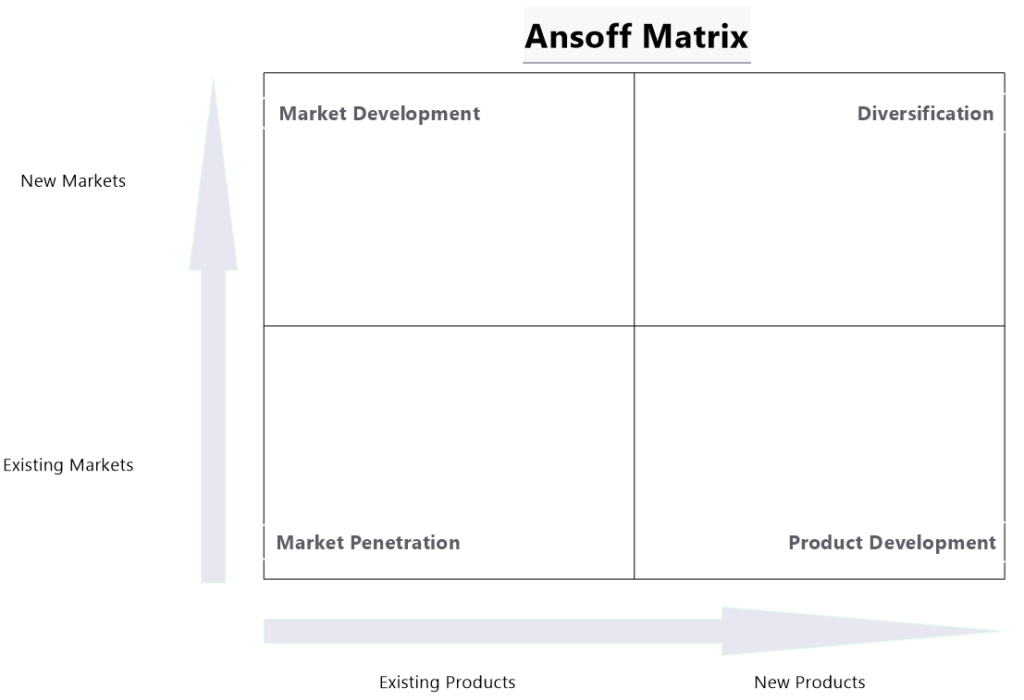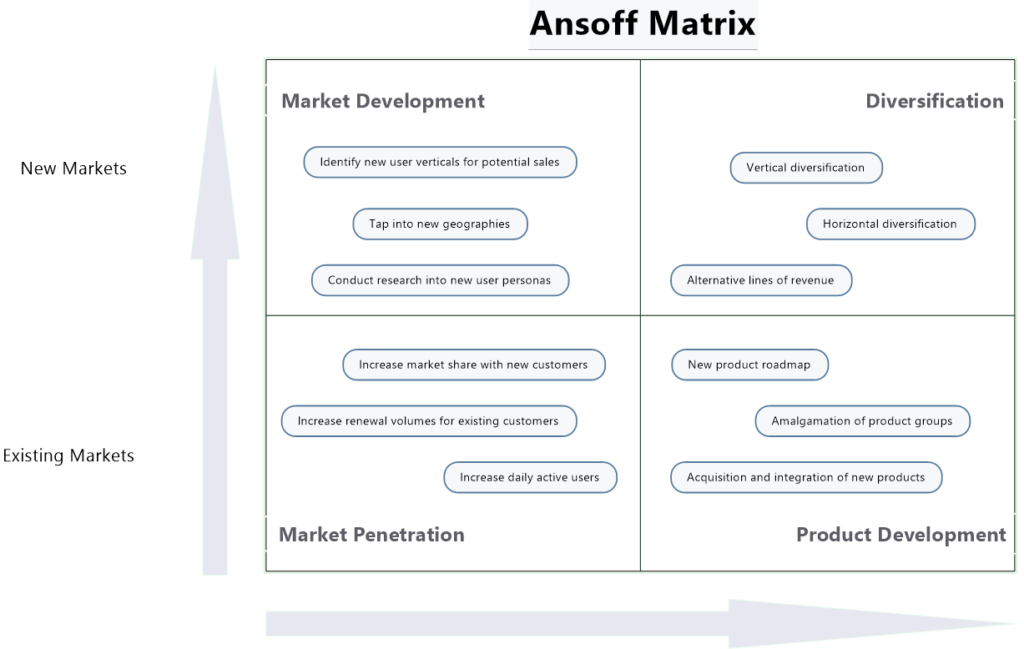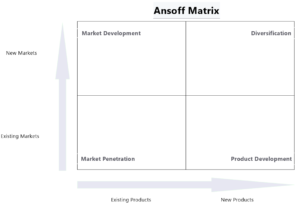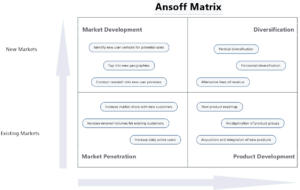By: Emily Finlay
Growth is the primary concern for most businesses. This development can take many forms, but eventual financial gain is typically the most important result.
To achieve sustainable growth, however, businesses have to determine the best ways to expand. Leading the company to a successful future requires careful strategizing. Should you expand your product line? Maybe it’s better to find new markets. Or should you find a completely new product and market entirely?
An Ansoff Matrix is a tool that can help you determine the best path for your company’s growth. With this simple diagram, you can discover the most beneficial direction to take your business and team.
What is an Ansoff Matrix?
The Ansoff Matrix definition is: a strategic planning tool that shows four different ways companies can grow through product or market expansion. By using the matrix, businesses can better understand the risks and challenges presented by each strategy.
The diagram, also known as the Product/Market Expansion Grid, was created by an applied mathematician and business manager named H. Igor Ansoff. He published the matrix, included in an article called “Strategies for Diversification,” in the Harvard Business Review in 1957. Over 60 years later, his work remains a powerful tool for businesses looking to expand and grow.
How to use an Ansoff Matrix
When using an Ansoff Matrix, you and your team will consider questions, risks, and opportunities that follow under four categories. These include:
- Market Penetration
- Market Development
- Product Development
- Diversification
As you can see in the example, these categories make up the four quadrants in the matrix. Moving into a new section, either vertically or horizontally, increases the risks of the actions you’re considering. Market penetration is the option with the least risks, while diversification holds the highest risks.

Let’s look into these quadrants a bit deeper.
Market Penetration
This option is the most simple and, as mentioned above, least risky. Rather than trying to develop a new idea, you would find new ways to make your existing product more appealing and successful within the market you already use.
Since you’ve already found some success in that arena, the challenge would be increasing sales by changing your marketing strategies instead of the product. You might accomplish this by running promotions, lowering your prices, or changing your distribution strategy. Whatever will attract new buyers and increase your sales, that’s the direction you need to go.
For example, a local bakery could expand by offering a loyalty program that rewards returning customers with free baked goods. They could also send a voucher for a free meal to anyone who signs up for their newsletter. Even though the business and product remain the same, these new strategies bring in fresh business.
Market Development
When market penetration doesn’t offer enough potential, it’s time to consider moving your products into a new market. This can include opening stores in new locations, targeting a new audience, or moving your products into international markets.
These moves give your successful products new exposure. Since you already know that there’s a need for your items, this is a great way to find more interest.
A silly sock company that caters only to adults can also begin offering a line for kids. Though the focus is different, the basic concept and materials are exactly the same. By targeting this new customer segment, they can sell more pairs than ever before.
Product Development
Conversely, product development involves creating new products for an existing customer base. These new offerings generate renewed interest in the company, retaining customers that might otherwise choose competitors with more products.
There are a couple of ways businesses can approach product development, such as:
- Creating a new product that appeals to your current audience.
- Developing a service related to your existing products.
- Partnering with businesses to offer a package deal that includes your product.
- Acquiring a competitor and using their value to increase your own.
Expanding your product line is risky and expensive, so this avenue requires in-depth research and development. You should only use this option if you have a strong grasp of your audience and a firm place within your existing market
One of the most prevalent examples of product development today can be found within streaming services. Though these companies, such as Disney and NBC, may have already reached every available viewer in their main market (creating entertainment), developing a streaming platform keeps these customers invested in the company. Along with a new stream of revenue, it also provides the opportunity to offer exclusive items only to subscribers and further solidify their market share.
Diversification
When the other three strategies are exhausted, it’s time to consider diversification. This quadrant is the most risky option for a reason. Diversifying involves creating a new product for a new market. Rather than relying on an existing customer base or product, this strategy starts from scratch.
That said, businesses can use related diversification to make things somewhat easier. Rather than creating a line of products that has nothing to do with your existing offerings (unrelated diversification), you can develop items that are similar. This allows you to use the knowledge and experience you’ve gained to direct your new venture.
When Apple began selling smartphones alongside their computers, tablets along with their smartphones, and watches with their tablets, for instance, these were examples of related diversification. The introduction of the Apple credit card and AppleTV, however, are reflections of unrelated diversification strategies.
How to create an Ansoff Matrix
You can create an Ansoff Matrix by making a four-quadrant grid that includes Market Penetration, Market Development, Product Development, and Diversification. The matrix should also show the overlap of new markets, existing markets, new products, and existing products for the quadrants.
You can create either virtual or physical versions with any medium you prefer, such as on paper, whiteboards, slideshows, and more. Using mapping software, such as MindManager, is also a great option. These tools offer options such as Ansoff Matrix templates and editing capabilities that further simplify creating and using your matrix.
How to use an Ansoff Matrix
To create your diagram, follow these steps:
1. Create your matrix
Using the tool of your choice, design your grid with each category, as described above. Templates are the best and easiest option, allowing you to save time and energy. This step, while important, should not take long to complete.
2. Consider your options
Next, plot the potential strategies you can pursue in each quadrant. Consider the practical ways you can grow the company. While you should be realistic about the viability of each idea, don’t limit your brainstorming. Think big and bold.
3. Run a risk assessment
Understanding the risks is the main point of the Ansoff Matrix. Use a Risk/Reward Matrix template to identify the ways you are putting your business in danger and the potential challenges involved. You can also use a risk impact/probability chart to order them by importance.
4. Plan for your risks
Now that you know what you might face, create contingency plans that address these risks. Focus on the risks with the highest probability and level of impact.
5. Select your approach
After walking through these steps, you will hopefully know which growth strategy is the best option to pursue. Take this direction and start planning how you’ll implement it!
Example of a Ansoff Matrix
When using this tool to develop growth strategies, use the Ansoff Matrix example below as a guide for your own diagram.

Ansoff Matrix use cases
Now that you know all about the Ansoff Matrix, we want to talk about the specific ways you can use it within your own business. Below, we’ve outlined some of the situations you may face and the best strategy to use.
Plateaued sales
If you have a good product that meets the needs of the people in your market, but you are struggling to attract new customers, consider market penetration. Offer rewards for referrals or a limited-time sale on your top-selling products. Give people a reason to learn about your brand.
Market saturation
When you’ve reached the limits of your current market, it’s time to branch out with market development. If you’re not already, start selling your products online. This can give you national and even global reach. You can also open a new location in a new city, bringing your products to a brand new crowd.
Questions about new products
If customers keep asking when you’re going to offer something, you should consider selling it. Product development increases your revenue and generates fresh interest in your brand. Just do your homework to make sure this is a sustainable option.
Needs that your products can’t solve
Are you seeing an unmet need? Do you have the ability to fill it? Even if it’s outside your sphere, this can be a life-changing opportunity to expand. Just remember, diversification is a risky move. Make sure you’re completely prepared and able to execute this shift before taking the jump.
Downloadable Ansoff matrix templates from MindManager
Click the images below to access the Ansoff matrix example shared above, and a blank template created using MindManager. Click “Menu” in the bottom left corner of your browser window, and then click “Download” to get a copy of the template. Open the template in MindManager to start working.
Don’t have MindManager? No worries! Try it free for 30 days.



